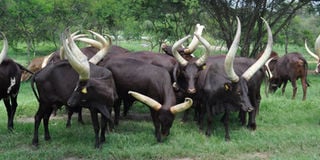Prime
Shift to friesians spells doom for longhorn cattle

Ankole longhorn cattle graze at Mwesigwa Resort Farm in Kiruhura District last Friday. PHOTO/JULIUS BYAMUKAMA
What you need to know:
It is said that the young generation of farmers has lost the intangible heritage of Ankole cattle due to the new era of exotic breeds.
The Ankole longhorn cow, over the years, has been a source of pride to Banyankole because of its beauty and smooth adaptation to the environment.
Longhorn cattle are one of the most indigenous breeds that are majorly kept by dairy farmers in Ankole Sub-region.
The major features of an Ankole cow are the long whitish horns and brown or dark brown skin.
There are also a few Ankole cows without horns. For example, the Nkungu breed (loosely translated as hornless cow). Other breeds are Kyozi (black skin) and Njeru (grey skin).
Banyankole love cattle with white horns and Bihogo (dark-brown skin) is the most preferred colour.
In tourism, the multi-coloured Ankole cattle such as Bugondo (white and brown spots), Enturature (several colours mixed), Kiremba (big patches of white and brown colour), Nkorongo (heron purple), Mayenje (spots on eyes) are the most loved due to their stunning beauty.
The Ankole cow is treasured in the Sub-region because of the role it plays in society including acting as bride price.
It is also a source of food, security and prestige in the society since the people there hold a strong belief that having cows in the community depicts one’s status in society.
“A family that never had cows was deemed vulnerable to all calamities because Ankole cows are believed to detect a stranger or a lion several miles away, thus informing the herdsman to prepare for safety. Up to present days, Ankole cows are a sign of wealth, prestige and great love for our heritage,” Mr Edmand Aryampika, the team leader at Destination Ankole, said.
Mr Aryampika said families that are keeping the Ankole longhorn cows have many benefits due to its unique products that include quality meat, milk and cheese.
“The influence of President Museveni and his South African counterpart, Cyril Ramaphosa in promoting longhorn cattle has created a lot of demand for the cow. In spite of having high quality milk and meat, much value of this breed is majorly ornamental, as well as for prestigious reasons,” he said.
He added: “In Uganda, a good Ankole bull fetches over Shs50m while in South Africa, a good cow or bull can fetch over Shs300 m in an auction at top farms.”
He, however, said times have changed as people attach the value of a cow to how many litres of milk it produces on a daily basis as a well-fed and mature Ankole longhorn cow can produce between 10 to 15 litres of milk per day.
This has forced dairy farmers to opt for Friesian cows that can produce about 20 litres of milk per day and this is threatening the existence of Ankole longhorn cattle.
Mr Emmanuel Kamihingo, a renowned Ankole cattle farmer and proprietor of Nshara Kamihingo Agro-tourism Farm, said keeping Ankole cattle was a major economic and cultural activity for people in the sub-region.
“Originally, Banyankore only kept longhorn cattle to the extent of some people making cattle their close relatives. The relation between farmers and Ankole cattle is because it was their only source of food. One would get milk, meat, cheese and sometimes use the skin hide to sleep on it,” he said.
Mr Kamihingo said in the past, nomadic pastoralism was the cause of little milk quantities among the Ankole longhorn cattle. He advised the youth to embrace preservation of longhorn cattle.
“The past governments did not do much to preserve the existence of the Ankole longhorn cattle until when the current government came to power. President Museveni advised us to keep cattle in our farms and homes rather than moving all the time,” he said.
He added: “Young generation, especially the youth, should love our Ankole cattle much as they have exotic breeds on their farms. They should embrace cultural heritage by rearing their traditional cows.”
Ms Winnie Nduhukire, who was crowned Ankole cattle queen in December, said the young generation has lost the intangible heritage of Ankole cattle due to the new era of exotic breeds.
“We are mobilising youth to love Ankole cattle heritage through social media posts. We are seeing positive response as more youth join our trips to visit Ankole cattle farms,” she said.
She added: “We are also developing Ankole cattle heritage books at different levels as well. There is a new wave of paying dowry using Ankole cattle and this is largely our efforts to instil and bring back Ankole cattle heritage, values and practices among the youth.”
The Minister for Agriculture, Animal Industry and Fisheries, Mr Frank Tumwebaze, said the government is doing enough research to preserve Ankole cattle breed.
“Our research and breeding institutions continue to preserve and conserve the Ankole cattle. They stock bulls for farmers and it is our priority to breed species. We encourage farmers to introduce Ankole cattle on their ranches,” he said.
He added: “We encourage them to, if possible, cross breed the Ankole cattle with Boran and other exotic breeds. By nature, Ankole cattle have the best meat.”
He further said challenges with keeping Ankole longhorn cows is that people do not have enough grazing grounds and that those who have the breed, do not want to share the breed with others.




